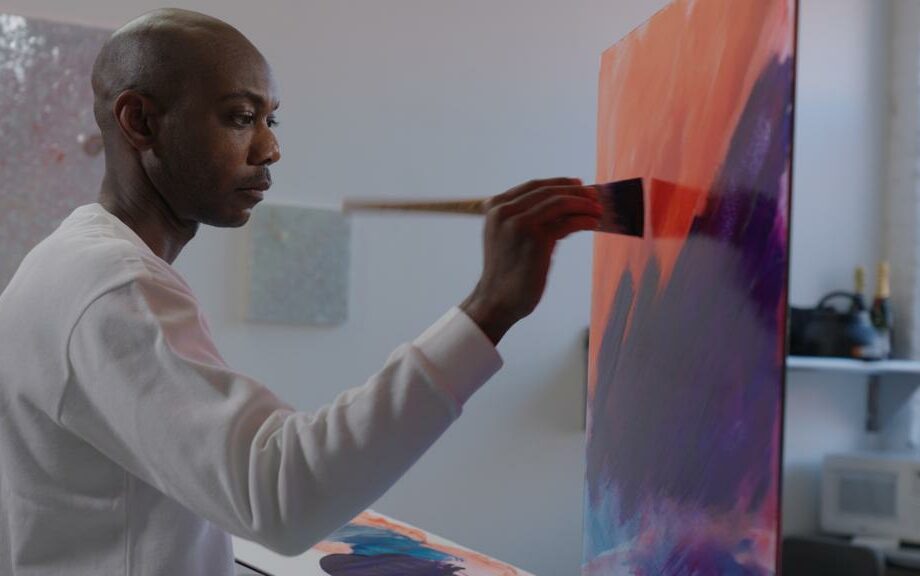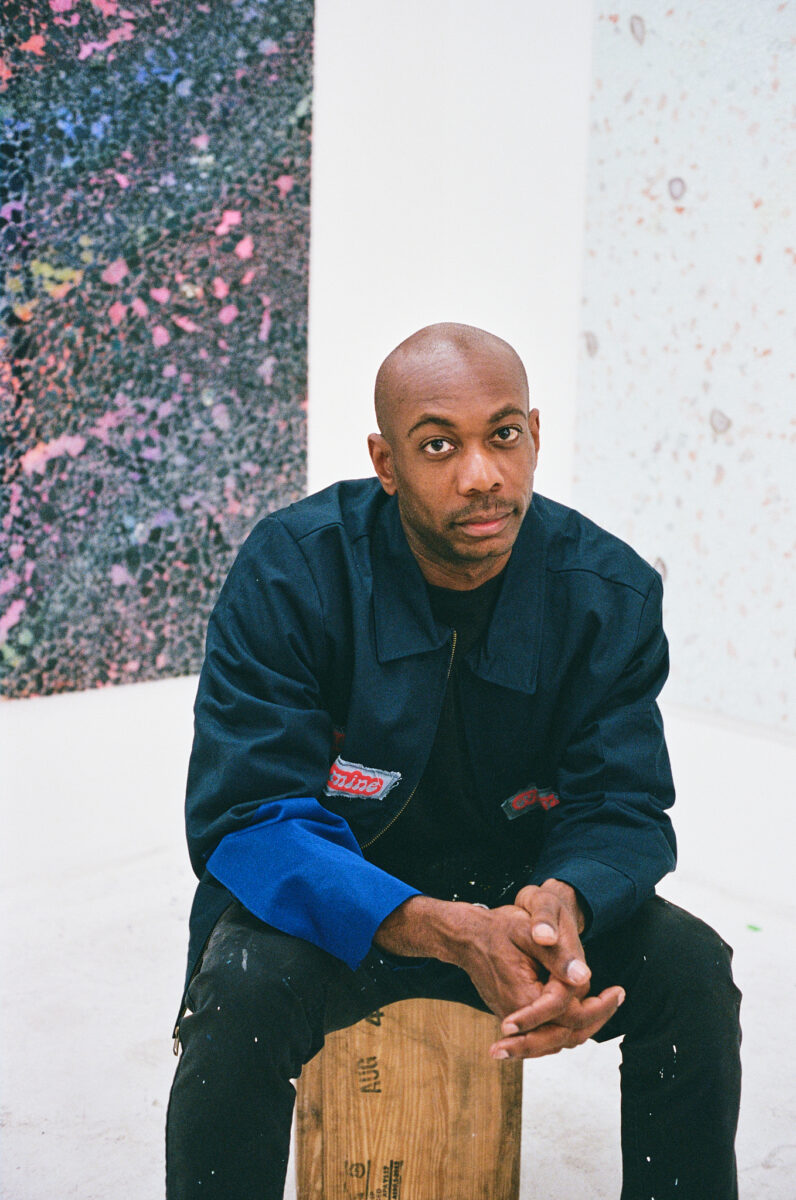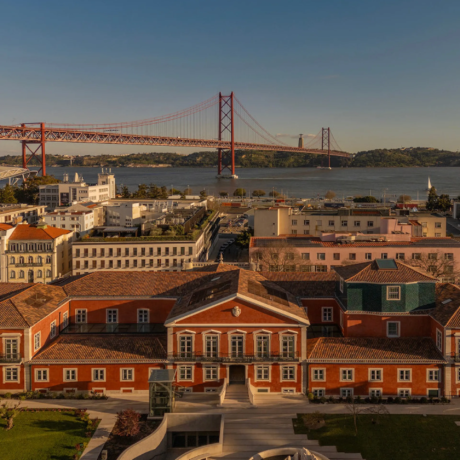When Alteronce Gumby was 26 years old, he floated through the sky and saw his silhouette haloed in a prism of colour beneath his outstretched arms. It was the painter’s first and final time skydiving; he wanted to fulfil his dream of passing through a cloud. “As we descended towards Earth, I noticed that our shadow cast on the cloud was creating a rainbow halo around us,” he remembers almost ten years later. The experience crystallized in his memory and is echoed in his abstract paintings made from shards of glass, gemstones, resin, acrylic paint, and reflective surfaces. “I think of myself as an artist explorer,” says Gumby. “With each painting, I’m trying to redefine colour for myself. Travelling allows me to do that, too.”

The Bronx-based painter has travelled through the sky and across continents to seek inspiration for his transcendent paintings. Now, he is continuing his odyssey in a forthcoming feature documentary aptly titled COLOR. The film will follow the artist across the world (and here in New York) as he explores the many facets of colour.
The idea for a documentary was born at the beginning of 2023. While mapping out his trips for the year (New Orleans for Mardi Gras, Norway for the northern lights), he had a lightbulb moment: what if he filmed his adventures and shared them with the world? He called his friend, the filmmaker John Campbell — who he met on the set of Campbell’s documentary mini-series “Who’s Behind Black Art?” — and the project snowballed from there. The two started filming in New Orleans and Mathura, India and began raising funds on Kickstarter to cover equipment, travel costs, a small crew, and production. Next week, the team will make their way to Marrakech, Morocco.

“The interesting thing about making a travel documentary is that I can be a stranger,” says Gumby. India, one of the first stops, was a welcome culture shock for the painter. He soaked in the new environment’s vibrancy. “I noticed the colour of the sarees, the colour of the fabrics; I noticed the colour of the food, with its rich curry spice; I noticed the colour of the landscapes, dusty with brown clay. It was a beautiful experience.” Gumby chose Mathura for its location as India’s annual Holi festival: a celebration where attendees douse each other with powder from pink to green to blue.
He set out to discover the origins of the holiday, he says, recounting a story told to him by a local: legend has it, Krishna’s love Radha covered her light skin in colourful pigments to match the beauty of the Hindu god’s dark complexion. “It just goes to show that in one place, lighter skin is preferred, then in other places, darker skin is celebrated,” he reflects.” How do we understand what it means to be Black? Or white? And who decides the ideal beauty standard? “It all depends on where you are,” answers Gumby. “Sharing stories from different cultures opens up our understanding of this. Especially in the age we are in now, with the internet: we should all be watching and learning from each other constantly,” he emphasizes, adding, “It’s another thing to see someone like me exploring these foreign countries.”

The artist’s research into the cultural undertones of colour began as he delved deeper into his practice as a painter. As he researched art history, the history of pigments, colour theory, and astrophysics, he began to understand colour as a conduit for ideas. “It was through that history that I really started noticing colour more for its political content — and personal context for myself,” he says. “I began to think about how the colour black was used as a psychological warfare to have people think that Black people are bad or negative or inferior as opposed to white. I noticed how these things are reinforced through art history and the history of black paintings from [Kazimir] Malevich and [Paul] Bilhaud.”

Following his graduation from Yale’s MFA program, the painter found himself in Paris for a year-long residency at the Fondation des États-Unis. While he was there, he saw a life-changing exhibition of Ad Reinhardt’s black square paintings. “I thought, I love these paintings,” he remembers. As Gumby researched Reinhardt and his black series (which, upon close inspection, revealed pigmented hues of blue, green, or red), he learned that the abstract painter viewed the colour as a void, a vacuum.
He wondered how Reinhardt could see emptiness where he saw limitless possibility. To the young painter, all of the nuances, the colours and geometric grids within the black squares seemed to be the opposite of a void. As Gumby began to dive deeper into the late artist’s practice, he came across an interview between Reinhardt and Cecil Taylor, the acclaimed jazz pianist and poet.

“Cecil Taylor was saying, ‘when I think of the colour black, I think of the back of my mother’s hand, I think of jazz music, I think Harlem and 125th Street, I think of church on Sunday,'” recalls Gumby. “I felt like my relationship to the colour black was more in tune with Cecil’s, being a Black man in America. So I started making these paintings based on the colour black, which are somewhat like this painting here,” Gumby says, directing our focus to a lustrous large-scale work, a continuation of his “Black(ness) is Beautiful” series that he worked on during his Paris residency. Dark, jewel-toned gemstones, glass, and acrylic paint cover the large canvas.
“At a distance, it seems black,” he observes as we approach the painting. “But when you get up close, you can see so many colours.” Greens, blues, and violet reflections shimmer from the black painting, catching the afternoon studio light. “All of these colours add to the experience of what you may perceive to be a black or dark painting; it’s much more complex. It’s much more diverse. It’s an amalgamation of all the colours coming together,” he says. In his studio, the colour black shines opalescent, a rainbow shifting in tone depending on the viewer’s vantage point.

Throughout his practice, Gumby has continued to develop a unique visual language grounded in colour. The colour black has remained a north star in his work, a source of inspiration and introspection that the artist often returns to, unearthing new shades of meaning. In 2020, he curated a group show titled A Muffled Sound Underwater at LatchKey Gallery with the artist Tariku Shiferaw that highlighted artists using the colour black to discuss culture and beyond. (The title references a quote from the theorist and poet Fred Moten). In his 2022 exhibition with Berlin’s Bode Projects at Zona Maco art fair in Mexico City, Gumby exhibited a series of black gemstone paintings inspired by a visit to Teotihuacán’s volcanic Pyramid of the Sun. The works featured obsidian, labradorite, black kyanite, shungite, and black tourmaline.
In his essay Blackness, Fred Moten traces blackness “way back, before the violent norm.” The poet and theorist finds blackness, in all its multitudes, to contain “the surrealisation of space and time, the inseparability of gravity and matter, fabric’s fabrication, field’s feel.” To understand this, he writes, “You have to use your imagination against the world, since in the world—that dream, that nightmare of dominion, overview, and oversight—blackness comes sharply into relief against its negation.”

Gumby uses his imagination against the world with such a force that it expands beyond it into the galaxy. “I started looking at our star, the sun, as a source of colour. As you look beyond that, there are hundreds of billions of stars in the known universe. Each one of those stars has its own fingerprint, its own signature palette, or what they would call the black body,” he explains.
“If you can imagine being on another planet in another solar system with a different atmosphere, the way you would see or experience colour would be different,” Gumby muses. His identity wouldn’t come with all of the cultural signifiers and prejudices that race and identity have on Earth. “If I walked into a bar on a different planet, I could just say ‘Hi, I’m Alteronce’ and let my identity start from there,” he says.
He points to a rectangular painting with strips of horizontal colours propped up against a studio wall. “This is a little bit of a self-portrait,” he reveals, standing next to the work, which is about his height. “I just love the way astrophysicists describe the spectrums of stars as black bodies, these perfect black bodies. This is my own take on that: it’s measuring the layers of colours that probably exist within me, that frequency, that colour spectrum.”

Soon into our conversation, his Bengal cat (fittingly named Cosmo Picasso) bounds into the room, affectionately brushing up against my leg before leaping onto the table and attempting to perch on the artist’s shoulder. I observe his oval, cheetah-like spots are perfectly at home among Gumby’s paintings. “I’ve been using some of his patterns in the works,” he agrees. Nearby, a fuchsia mirrored piece with a scatter of clear crystals rests on a table. He leans in to inspect the gemstones, and I glimpse his pink-tinged reflection in the work.
Gumby is one of those rare artists who seems to switch between his right and left brain with ease: one moment, he is speaking about astrophysics and the colour index. Next, he waxes poetic about the spiritual properties of celadonite, a crystal which “invokes a sense of clarity.” A large, translucent point of quartz sits on his palette table, drenched in soft sunlight. The gemstone’s presence helps him maintain a focused mind when painting.
His large-scale paintings recall Jack Whitten’s mosaic-like, multicoloured tesserae paintings in the same breath as Claude Monet’s “Water Lilies” series, which captured the dynamic effects of light. “Sometimes when I’m looking at Monet’s water lily paintings, I feel like I’m not only looking at the water lilies, but I’m also looking at these overcast clouds that appear to be passing through or the sunset or sunrise happening across the sky,” he says. “Maybe he’s also looking at the reflection of the clouds and sky, and through observation, seeing beyond, beyond the clouds to a cosmic landscape.”

As I watch Gumby — who is standing in front of one of his recent white paintings dotted with clear gemstones and glowing pale green undertones, a painting that, like his black works, reflects a spectrum of colours — and listen to him imagine Monet gazing at (and beyond) the sky, I can’t help but think that he could also very well be describing the work behind him.
In his 2017 debut solo show at Long Gallery in Harlem titled Reading Rainbows, inspired by countless hours of observing the night sky, the young artist defined what would become a lifelong exploration of colour. “Gazing at the sky, our window to the cosmos, allowed me to look beyond the tragic realities of today and begin to compose moments of peace,” he wrote in his artist statement. “Often I ask myself, ‘What does it mean to be an artist of colour and make paintings about colour?'” he continues. “The ability to recontextualize hue through abstract painting is the most emancipating act in my practice. I consider colour to be more than just a hue, a race, a mood, a shade, a mark, a line, a man, a woman, a country, or a nation. It’s an amalgamation of experiences, signs, and signifiers that tell a story. My story. Written and rewritten with each painting.” And six years later, the painter continues his cosmic journey, building a new visual language to capture the colourful prism of human experience.
You can learn more about Gumby’s forthcoming documentary and donate here.
Words by Meka Boyle





